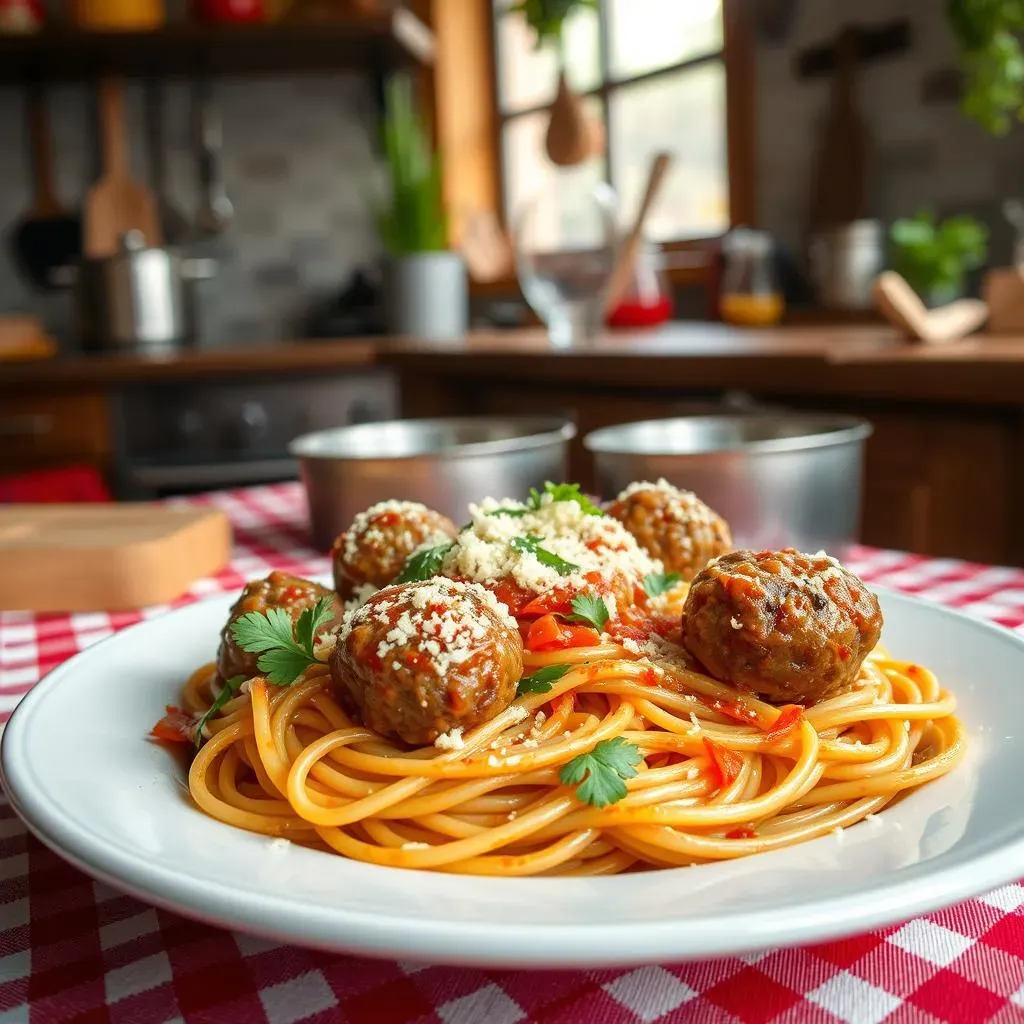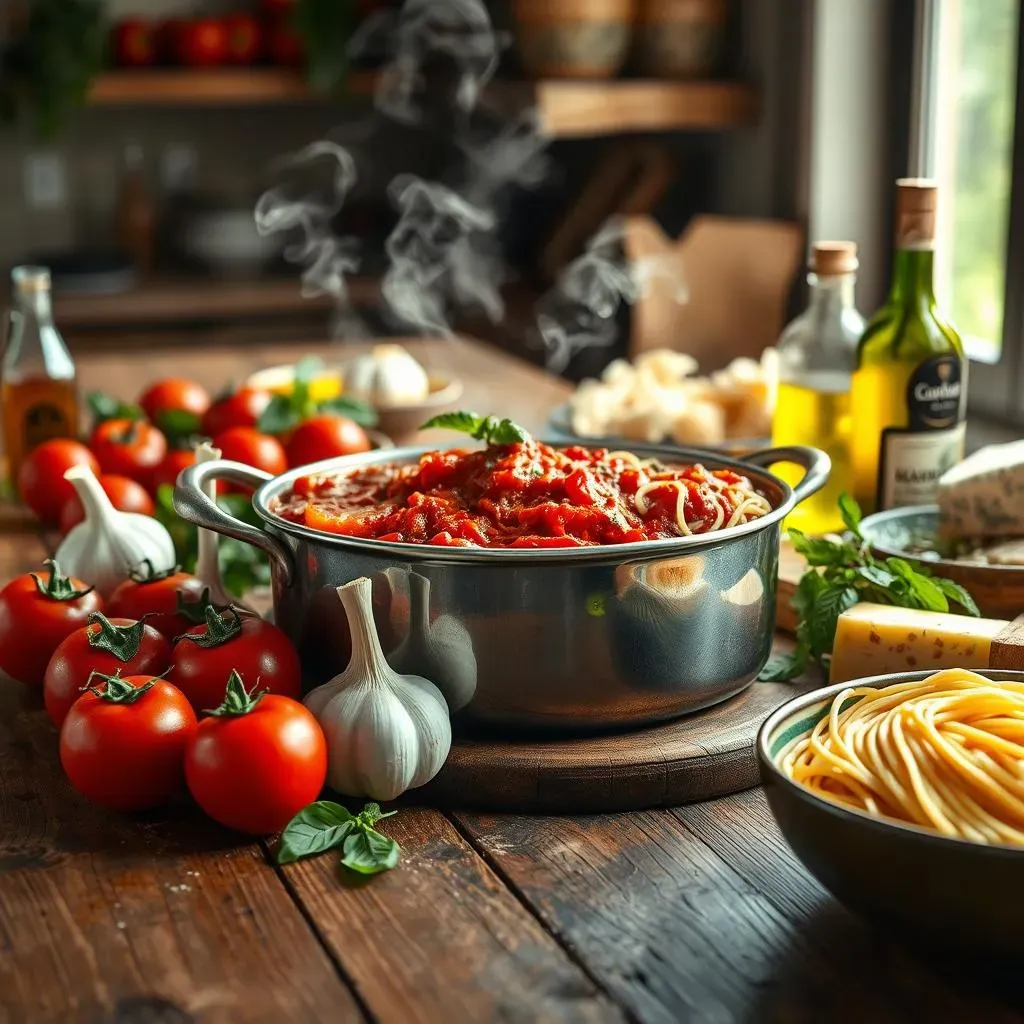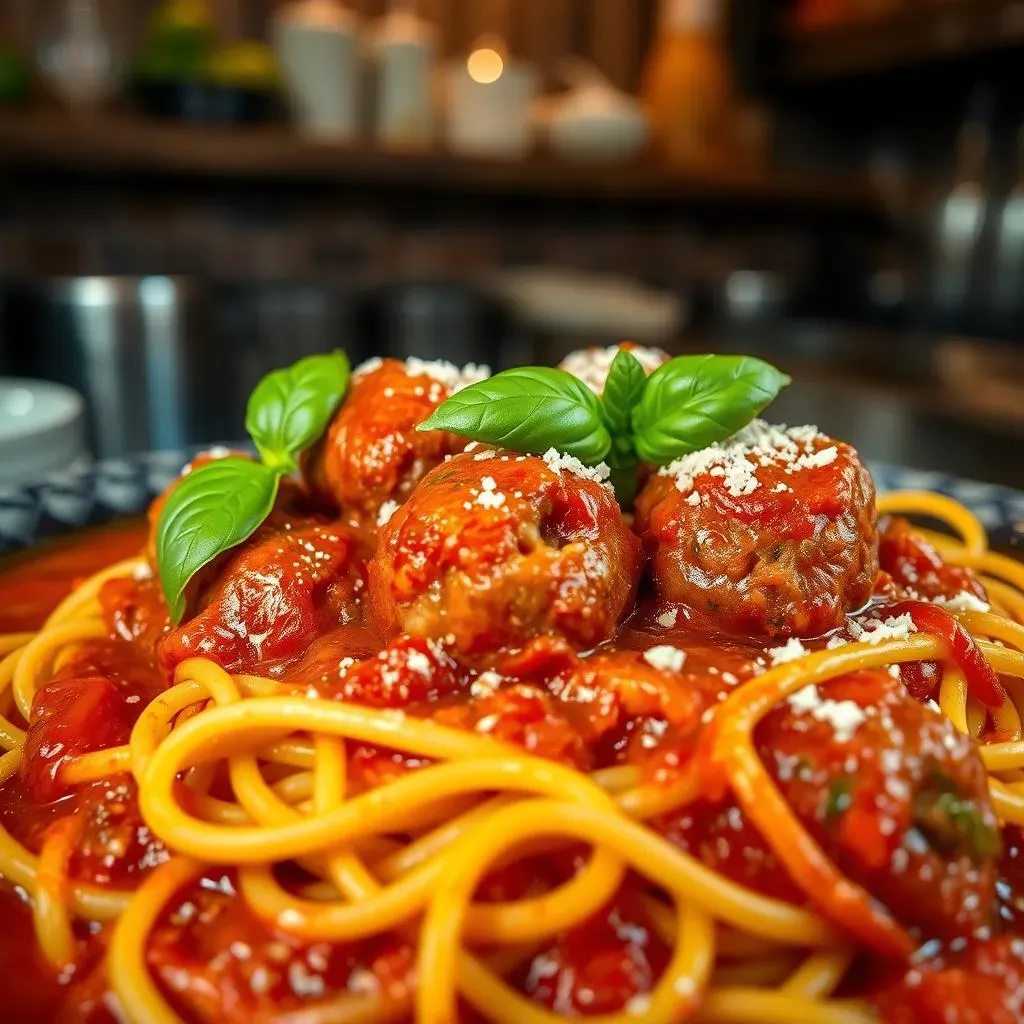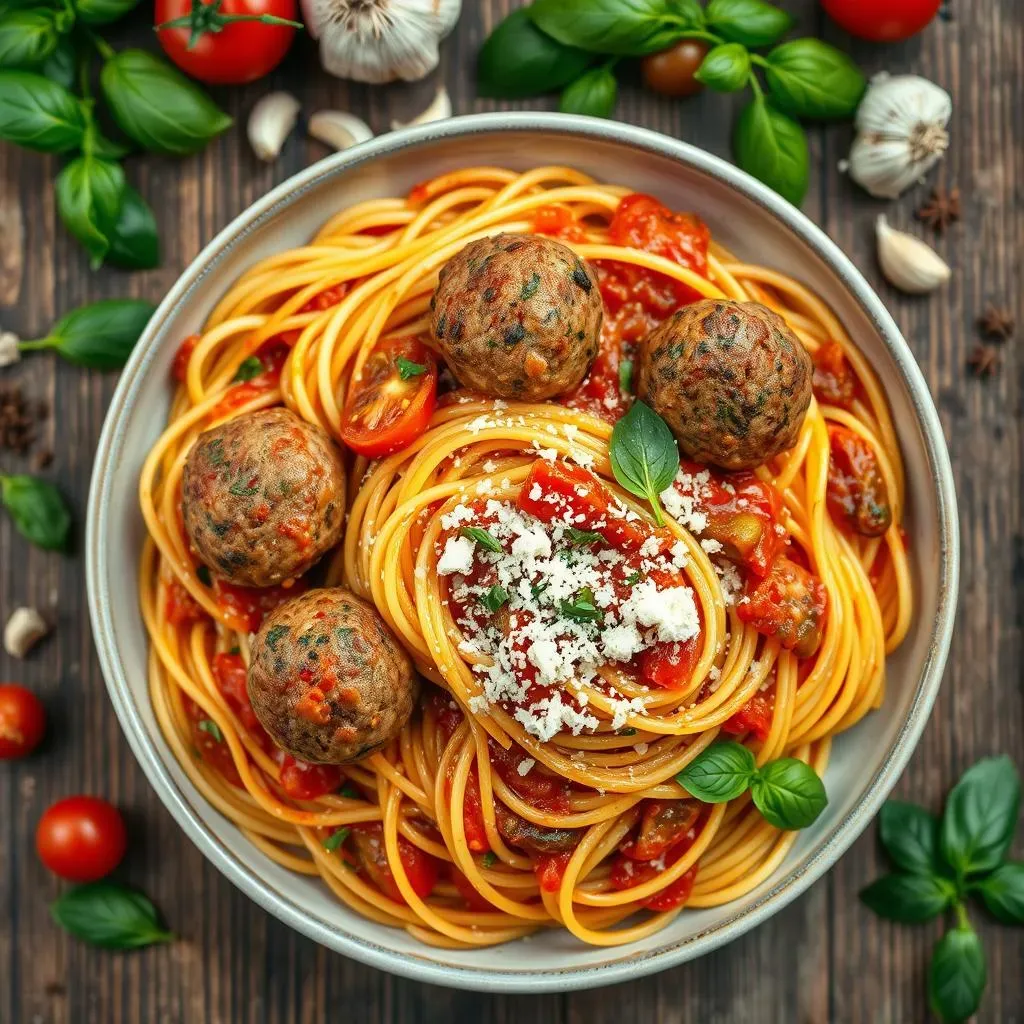Is there anything more comforting than a big bowl of spaghetti and meatballs? Forget the jarred sauce and frozen meatballs, because today, we're diving headfirst into creating the ultimate homemade meatballs and spaghetti recipe. This isn't just about following instructions; it's about crafting a dish that feels like a warm hug from the inside out. We'll start by mastering tender, flavorful meatballs, exploring the secrets to achieving that perfect texture and taste. Then, we'll move on to a rich, vibrant tomato sauce, built from scratch with simple ingredients and simmered to perfection. Finally, we'll bring it all together, layering flavors and textures for a truly unforgettable meal. Get ready to roll up your sleeves and transform your kitchen into a haven of delicious aromas, because the best spaghetti and meatballs you've ever tasted is just a few simple steps away. This guide will walk you through each stage, from selecting your ingredients to serving up a masterpiece. So, grab your apron, and let's get cooking!
Crafting the Perfect Homemade Meatballs for Spaghetti

Crafting the Perfect Homemade Meatballs for Spaghetti
Choosing Your Ground Meat
so you want the *perfect* meatball, right? It all starts with the meat. Don't even think about grabbing that pre-packaged, super lean ground beef. We're going for flavor and tenderness here. A blend is your best bet. Think ground beef and ground pork – the pork adds a richness that beef alone just can't achieve. A good ratio is about 50/50. If you're feeling adventurous, a touch of ground veal can elevate things even further, but it's not essential.
Now, about the fat content. Lean ground beef will result in dry, crumbly meatballs. Aim for around 80/20 ground beef, meaning 80% lean and 20% fat. That fat is going to render during cooking, keeping your meatballs moist and delicious. Trust me, you don't want to skimp on the fat here. It's flavor, it's moisture, it's everything!
- Ground Beef: 80/20 blend for optimal flavor and moisture.
- Ground Pork: Adds richness and depth.
- Ground Veal (Optional): For an extra touch of tenderness.
Binding and Seasoning Like a Boss
So, you've got your meat blend sorted. Awesome! Now comes the crucial part: binding and seasoning. This is where you can really inject some personality into your meatballs. First, the binder. We're talking breadcrumbs, but not just any breadcrumbs. Panko breadcrumbs are fantastic because they're light and airy, preventing the meatballs from becoming dense. Soak them in a little milk or cream before adding them to the meat mixture – this helps keep things moist.
As for seasoning, don't be shy! Garlic is a must, of course. Freshly minced is always best, but garlic powder will do in a pinch. Add some finely grated Parmesan cheese for a salty, savory kick. Fresh parsley adds a touch of brightness. And don't forget the basics: salt, pepper, and a pinch of red pepper flakes for a little heat. The key is to combine everything gently – overmixing will result in tough meatballs. Use your hands, but don't squeeze the mixture too much. Just enough to bring it all together.
Ingredient | Amount (per pound of meat) | Notes |
|---|---|---|
Panko Breadcrumbs | 1/2 cup | Soaked in milk or cream |
Garlic | 2 cloves | Minced |
Parmesan Cheese | 1/4 cup | Finely grated |
Fresh Parsley | 2 tablespoons | Chopped |
Salt | 1 teaspoon | Adjust to taste |
Black Pepper | 1/2 teaspoon | Freshly ground |
Red Pepper Flakes | Pinch | Optional, for heat |
The Secret to a Delicious Homemade Spaghetti Sauce

The Secret to a Delicious Homemade Spaghetti Sauce
Start with Quality Tomatoes
Seriously, this is non-negotiable. The foundation of any great spaghetti sauce is, well, great tomatoes. Ditch the watery, flavorless canned stuff. We're talking San Marzano tomatoes, my friend. These are the gold standard for a reason – they're sweet, meaty, and have low acidity. You can find them whole, peeled, or crushed. Whole peeled are my personal preference because you have more control over the texture. Just crush them by hand as you add them to the pot.
If you can't find San Marzano tomatoes, look for other high-quality canned tomatoes. Read the labels! You want tomatoes that are packed in their own juice, with no added salt or sugar. And if you're feeling ambitious, you can even use fresh tomatoes during the peak of summer. Just blanch them, peel them, and chop them before adding them to the sauce.
Building Layers of Flavor
tomatoes are key, but they're not the whole story. A truly delicious spaghetti sauce is all about building layers of flavor. Start by sautéing some aromatics in olive oil. Onions and garlic are essential, of course. Cook them low and slow until they're softened and fragrant. Then, add a pinch of red pepper flakes for a little heat. Some people like to add carrots and celery (mirepoix) for extra sweetness and depth.
Next, it's time to add the tomatoes. Simmer the sauce for at least an hour, or even longer if you have the time. The longer it simmers, the more the flavors will meld together. Season with salt, pepper, and a pinch of sugar to balance the acidity of the tomatoes. Fresh basil and oregano added towards the end of cooking will brighten up the sauce.
The Finishing Touches
Almost there! Before you toss that sauce with your spaghetti, there are a few finishing touches that will take it over the top. A knob of butter stirred in at the end adds richness and silkiness. A splash of red wine vinegar brightens the flavors and adds a touch of acidity. And don't forget to taste and adjust the seasoning as needed.
If you're adding meatballs to the sauce, do it during the last 30 minutes of simmering. This will allow the meatballs to absorb the flavors of the sauce and vice versa. And finally, when you're ready to serve, don't drown the spaghetti in sauce. A little goes a long way! Top with a generous grating of Parmesan cheese and a sprinkle of fresh parsley.
Ingredient | Purpose |
|---|---|
Olive Oil | Base for sautéing aromatics |
Onion & Garlic | Aromatic foundation |
Red Pepper Flakes | Adds heat |
San Marzano Tomatoes | Main flavor component |
Salt, Pepper, Sugar | Seasoning and balance |
Fresh Basil & Oregano | Brightens the flavor |
Butter | Adds richness |
Red Wine Vinegar | Adds acidity |
Putting It All Together: Cooking Spaghetti and Combining Flavors

Putting It All Together: Cooking Spaghetti and Combining Flavors
Cooking the Perfect Pasta
Alright, the meatballs are ready, the sauce is simmering – now it's time for the spaghetti! Don't underestimate this step; perfectly cooked pasta can make or break the dish. First, use a large pot with plenty of water. Seriously, more water is better. It helps the pasta cook evenly and prevents it from sticking together. Salt the water generously – it should taste like the sea. This seasons the pasta from the inside out.
Add the spaghetti once the water is at a rolling boil. Cook it according to the package directions, but subtract a minute or two. You want the pasta to be al dente, meaning "to the tooth" in Italian. It should be firm and slightly chewy, not mushy. Reserve about a cup of the pasta water before draining. This starchy water is liquid gold – it helps the sauce cling to the pasta and creates a creamy emulsion.
- Large Pot: Use plenty of water to cook the pasta evenly.
- Salt the Water: Season the pasta from the inside out.
- Al Dente: Cook the pasta until it's firm and slightly chewy.
- Reserve Pasta Water: Liquid gold for a creamy sauce.
Marrying the Sauce, Pasta, and Meatballs
this is where the magic happens. Don't just dump the spaghetti on a plate and drown it in sauce. We're going for a harmonious blend of flavors and textures here. Add the drained spaghetti to the pot with the sauce and meatballs. Toss everything together gently, using tongs to coat the pasta evenly. Add a little of the reserved pasta water if the sauce is too thick.
Continue to toss and cook for a minute or two, allowing the pasta to absorb the sauce. The starch in the pasta water will help create a creamy, emulsified sauce that clings to every strand. Serve immediately, topped with a generous grating of Parmesan cheese and a sprinkle of fresh parsley. And there you have it – a perfect plate of spaghetti and meatballs, made with love from start to finish.
Tips and Variations for Your Homemade Meatballs and Spaghetti Recipe

Tips and Variations for Your Homemade Meatballs and Spaghetti Recipe
Spice It Up: Adding a Kick to Your Meatballs and Sauce
Feeling adventurous? Let's talk about adding some heat and unique flavors to your homemade meatballs and spaghetti recipe. For the meatballs, consider incorporating ingredients like finely chopped Calabrian chilies, a pinch of cayenne pepper, or even a dash of your favorite hot sauce into the meat mixture. Smoked paprika can also add a wonderful depth of flavor.
As for the sauce, don't be afraid to experiment with different herbs and spices. A bay leaf added during simmering can impart a subtle, aromatic flavor. A splash of vodka can also enhance the tomato flavors and add a touch of complexity. And if you're a fan of garlic (who isn't?), try roasting a whole head of garlic and adding the softened cloves to the sauce for an extra garlicky punch.
Veggie Power: Sneaking in Extra Nutrients
Want to make your homemade meatballs and spaghetti recipe a little healthier? Sneak in some extra veggies! Finely grated zucchini, carrots, or spinach can be added to the meatball mixture without significantly altering the taste or texture. Just make sure to squeeze out any excess moisture from the veggies before adding them.
For the sauce, consider adding finely diced bell peppers, mushrooms, or eggplant. These veggies will add extra nutrients and fiber to your meal. Roasting the vegetables before adding them to the sauce can also enhance their flavor and sweetness. It's a great way to get your kids (or yourself!) to eat more veggies without even realizing it.
Meatball Mania: Exploring Different Protein Options
While the classic beef and pork combination is delicious, there are plenty of other protein options to explore for your homemade meatballs and spaghetti recipe. Ground turkey or chicken can be used for a lighter, healthier alternative. Just be sure to add a little extra olive oil or breadcrumbs to the mixture to prevent the meatballs from drying out.
For a vegetarian option, try using a combination of lentils, beans, and vegetables. You can also add some grated Parmesan cheese or breadcrumbs to help bind the meatballs together. Serve with a flavorful tomato sauce and whole-wheat spaghetti for a complete and satisfying meal.
Savoring Your Homemade Meatballs and Spaghetti Masterpiece
Congratulations, you've just created a truly exceptional homemade meatballs and spaghetti recipe! From the perfectly seasoned meatballs to the rich, slow-simmered sauce, every element of this dish was crafted with care and attention. This isn't just a meal; it's an experience, a taste of tradition, and a testament to the power of homemade goodness. Whether you stick to the classic recipe or experiment with your own variations, the joy of sharing this dish with loved ones is what truly makes it special. So, gather around the table, savor each bite, and bask in the satisfaction of a meal well made. And remember, the best recipes are the ones that are shared and enjoyed, so don't be afraid to pass this one on!